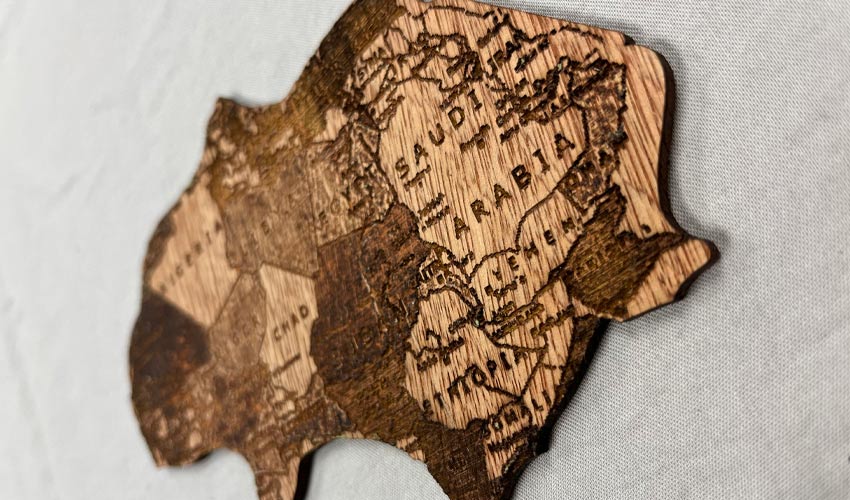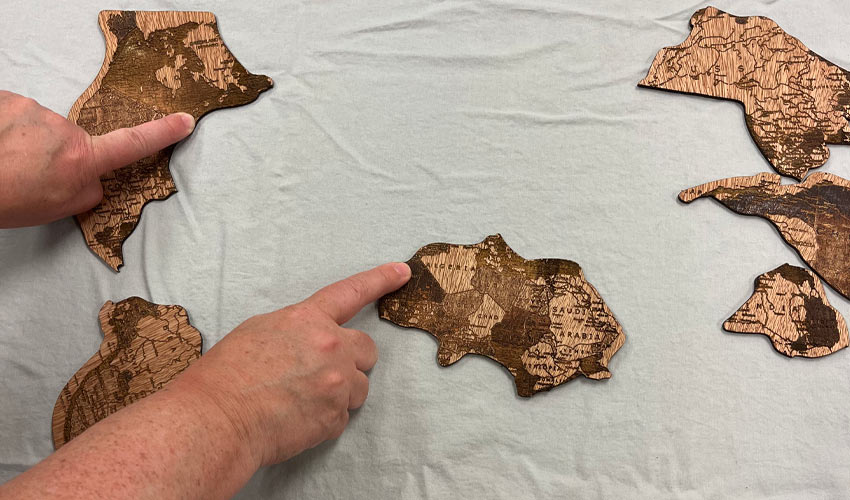A continental puzzle
Exploring Pangaea and the link between Nova Scotia and Morocco
— Mount Royal University | Posted: December 9, 2022

Student Areesha Noor created a wooden puzzle using the Library's Maker Studio that helps depict how far continents have moved apart over the last approximately 250 million years.
While many people think of geology as the study of rocks, that is just part of what the science actually is.
By definition, according to Dictionary.com, geology is a “science that deals with the earth's physical structure and substance, its history and the processes that act on it.”
Geology impacts almost every aspect of our daily lives, says Associate Professor Katherine Boggs, PhD. Everything that can’t be grown, must be mined.
“For example, we wouldn’t be able to have a conversation on the phone without copper. Inside basically everything that is technological, there are a whole variety of elements like cobalt, lithium and nickel, which are quite important for batteries,” Boggs says.
Many green energies still require natural resources, Boggs explains. Neodymium, which is required to make wind turbines, is not a rare chemical element, but it doesn’t occur in large quantities. Generally, at least 27 kilograms (60 pounds) of neodymium goes into a single turbine, and it is difficult to process or purify.
While the earth’s natural elements are required for virtually everything, geology is also helpful in the understanding and mitigation of natural disasters.
Volcanic eruptions, earthquakes, tsunamis and extreme weather occurrences such as flooding, are studied through geologic processes to better understand them and better mitigate them in the future. Boggs says such events and systems are very complex and it is hard to predict exactly when a volcano might erupt or an earthquake might happen, but geology can be used to understand the warning signs.
“What we do is we create these maps of risk analysis. For earthquakes, the highest risk in Canada is on the west coast. We know that they occur on a cycle that is between 300 and 500 years because we have records in the sediments on the ocean floor for thousands and thousands of years,” Boggs says.
The last major earthquake, according to Boggs, was back in 1700. Given that it is now 2022, we are within the time zone of what she calls a megathrust earthquake.
“And that’s why people are very concerned and why people are taking it very seriously. They’re developing an early earthquake warning system on the west coast, but also in the St. Lawrence Seaway system.”
Unlikely cousins from Eastern Canada and Northern Africa
Not only can geologists predict what significant natural events might happen by using specific methods and measurements, they can also provide a better understanding of the world as it was. Thanks to geology (and other disciplines as well), it is now known that two unlikely neighbours were once connected: Nova Scotia and Morocco.
While the Canadian province and African country are quite literally an ocean apart (almost 5,000 kilometres), similar fossils have been found in the two regions and their rugged coastlines fit together like a puzzle. They were joined together as part of a supercontinent named Pangaea that existed during the late Paleozoic and early Mesozoic eras.
Boggs says plate tectonics was not a widely accepted theory until the late 1960s. Before then it was thought that most plate movement was only vertical, not horizontal.
“Morocco and Nova Scotia have similar rocks of similar ages, similar fossils of similar ages. If you remove the Atlantic Ocean and bring the province and the country back together, you can see where they align.”
This discovery is important for many reasons, one being that it demonstrates how fast the earth’s tectonic plates move. For context, Boggs says they travel about as fast as our fingernails grow, “somewhere between one centimetre and 20 centimetres a year.”
Boggs has seen the exact lava flows resulting from the movement at the Bay of Fundy during a trip to Canada's east coast earlier this year. She also had the opportunity to connect with a researcher in Marrakech, Morocco, who is studying the same lava flows.
Students learn more about Pangaea in Boggs’ Geology 1109: Introduction to Geology course.
Areesha Noor, a third-year business student, decided to take the class because she wanted to know more about how the earth works, but she took extra interest in the drifting of the supercontinent.
“Katherine gave us a quick look and explanation about Pangaea, about the supercontinent and the super-continental drift. It was just one lecture but it really stuck in my mind. Even after 12 more interesting lectures it was just something that I captured and could not get over.”

Nova Scotia, on the left, and Morocco on the right, have coastlines that perfectly match each other. The two were once conected as part of Pangaea.
During that class, Boggs assigned a project in which students were allowed to take any aspect of the geosciences and create some sort of deliverable.
Noor says she always knew about the Maker Studio in the MRU Library, but she didn’t know how to use the equipment there or what it could even be used for until she was assigned this project.
“In the Maker Studio I was made aware of a lot of machinery. I never thought that this kind of machinery even existed, as well as the programs and software they had, too.”
With the help of some of the Maker Studio staff, Noor came up with the idea to create a wooden puzzle of Pangaea to show how Nova Scotia and Morocco fit together.
“I used the laser machine to cut the pieces and then we engraved the countries and provinces on the puzzle. And then we had to piece it together and create a nice frame for it,” Noor says, who notes it took her several weeks and multiple visits to the library to complete the project.
The puzzle can also be pulled apart to demonstrate how the continents drifted.
Noor says she is still planning to finish her business degree, but thanks to this class she is inspired to learn more about geology.
“I have changed my mind. Now I want to pursue something in the geology field, maybe oil and gas or maybe something to do with rocks and mountains.”
Dig deep into the earth’s history with geology studies at MRU.

